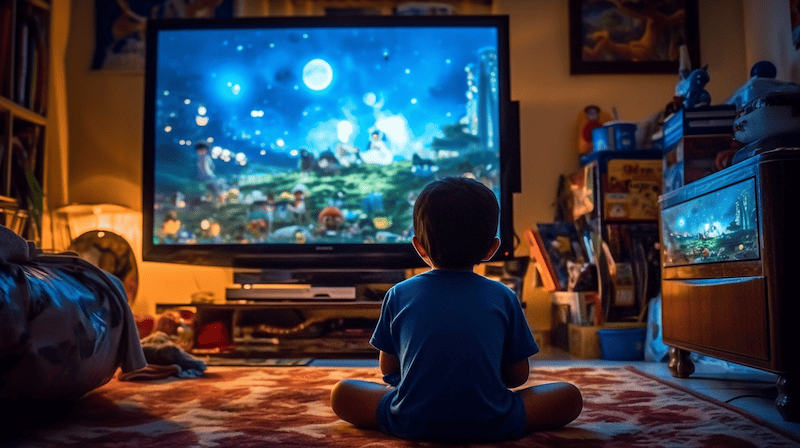Raising kids in the digital age can be a challenge. With all the available technology, managing your child’s screen time is hard while allowing them to enjoy their favourite cartoons. It is possible, though!
Here are some tips for helping you balance both so that they get the most out of their viewing experience without sacrificing your rules and regulations. We know how important it is to keep our kids safe and healthy, but we also don’t want to take away from them enjoying one of life’s great pleasures – watching cartoons!
By following these simple guidelines, you’ll be able to give your children an enjoyable cartoon-viewing experience while still maintaining control over when, what, and how much they watch.
Establishing Screen Time Guidelines
We all want our kids to enjoy the experience of watching cartoons, but at the same time, we need to be mindful of how much screen time they’re getting.
As an adult, who would have thought allowing your child a few minutes of entertainment on television could lead to such big decisions? It sounds ridiculous, yet here we are – struggling with balancing educational and entertaining content for our children’s benefit!
While it can feel overwhelming trying to figure out what works best for everyone involved, there is an important lesson: learning how to set boundaries when using technology can help us strike a balance between having fun and being responsible.
With thoughtful planning and guidance, parents can ensure their children get the most out of their screen time while enjoying those beloved cartoons.

Balancing Educational And Entertaining Content
Having established screen time parameters and balancing educational and entertaining content is essential. If you have a child who watches cartoons on the television, smart tablet, or phone, it’s good to know why they watch them. Is it solely for entertainment, or are educational lessons also being learned?
Regardless of the reason, it will save you and your child stress to openly talk about their limitations when they jump to watching TV or other forms of media. With that, you can mitigate any bad habits or dependencies on screen time.
By providing your child with access to educational programs, like popular cartoon channels on YouTube or Netflix Kids, you can help them learn while having fun. These cartoon streaming platforms offer more than just colourful characters but also light guidance that makes it easier for kids to learn about daily challenges through adventure, which an adult may not be able to provide.
While granting kids access to unrestricted surfing and screen time is bad, television cartoons are similar to taking a course on life lessons, which your kids can share with friends and even the adult in their life!
Additionally, cartoons also offer kids a media medium for learning new words. In most cases, kids today learn a word from shows they watch and remember them based on the storyline presented to them!
Watching cartoons can be an excellent way for kids to have fun while learning about people and the world around them. People often overlook how much good can come from watching something like this; if done in moderation, cartoons can help young ones build problem-solving skills and understand emotions better.
In addition, they are very creative and imaginative, encouraging young minds to explore various aspects of life with an open mindset. Therefore, it is beneficial to encourage children to watch and explain why doing so has its merits.
Explaining The Benefits Of Watching Cartoons
Did you know children aged 3 to 7 average 4.4 hours of screen time daily? That screen time is divided into watching cartoons, playing games, and messaging friends. During the hours they watch cartoons, kids tend to learn more than the other activities they perform on their devices.
Cartoons are a great way to keep kids entertained and engaged while providing educational opportunities. The Nation Institute of Education in Singapore partnered with University researchers to study the impact of cartoons on a child’s learning.
Their findings suggest that using cartoons as part of learning modules in younger children can increase the speed of learning while also being an enjoyable experience.
Cartoons also have a positive effect on cognitive development. Not only do cartoons help children learn more quickly, but they also develop their language skills and problem-solving capabilities. Cartoons are an excellent way to keep kids mentally active as well.
Watching cartoons can provide the following:
- An exciting adventure they will love – with stories full of excitement, suspense and humour!
- A chance to learn about different characters and their personalities
- The opportunity to explore significant life lessons like friendship, family and courage
Seeing the world through cartoon eyes provides an enjoyable experience for children as it helps them develop empathy and emotional intelligence.
At the same time, however, parents must be mindful of what type of content suits a child’s age level.
It is essential to ensure that your child is watching age-appropriate shows to maximize the benefits associated with screen time.

Choosing Age-Appropriate Cartoons
As adults, it cannot be easy to understand why our children find so much joy in watching cartoons. But there is a perfect balance between allowing your child to watch their favourite shows and managing screen time appropriately.
Cartoons offer educational benefits, provided it is age appropriate and watched in good time intervals. They are a great entertainment source that helps young minds stay engaged and creative. And while they may not necessarily learn life lessons from the characters, cartoons are an excellent way for children to think through different scenarios without experiencing them first-hand.
However, finding quality content is essential when choosing age-appropriate cartoons – something we will discuss further in the next section.
Finding Quality Content
Ensuring your child is watching quality content while engaging in screen time is essential.
To make sure this happens, you can:
- Monitor what shows or movies they watch on TV.
- Vet the channels and videos they watch on YouTube.
- Share with them any age-appropriate educational websites that are available for their viewing pleasure.
Finding quality content for your child to view opens up a whole world of possibilities beyond just streaming cartoons; incorporating non-screen activities into their day allows them to explore different interests as well!
Incorporating Non-Screen Activities
Finding quality content for kids to watch is a great way to ensure they learn something meaningful while enjoying their cartoons. But it’s also important to save time so our little ones can explore other activities and things.
Beyond setting limits on how long they can watch cartoons, encouraging them to participate in non-screen activities like reading books or playing outside helps create a balanced lifestyle. Plus, they’ll be able to appreciate the joys of life without relying solely on what they see on screens!
There are many creative ways to get your child involved with offline experiences – from doing art projects at home to exploring nature trails nearby. Letting them have fun discovering new things will help foster creativity and allow them to look at the world around them through fresh eyes.

Encouraging Time Away From Screens
Fostering self-control in our children is a noble endeavour, and it starts with encouraging time away from screens.
While the idea of doing anything other than watching cartoons may seem like an uphill battle to many kids, there are courses we can take as parents to help teach them how to manage their screen time better.
Start by introducing a regular bedtime routine, which creates an expectation of when your child should turn off their screen. Additionally, try to keep screens out of the bedroom, as this can make it harder to enforce a healthy routine.
Another way to foster self-control is to be clear and consistent about screen time limits. For example, setting daily or weekly screen time limits can help your child better understand the importance of self-control and how it applies to their lives.
Finally, use positive reinforcement when your child effectively manages screen time. A simple “good job” or a pat on the back can go a long way in reinforcing the idea that self-control is a desirable trait.
By taking these steps, you will be better able to help your child develop the self-control to make healthy and responsible decisions about their screen time.
These concepts must become second nature instead of being seen as something they need to do when prompted by adults; taking the proper steps now will set your child up for success.
By teaching screen time self-control at an early age, parents can empower their children and give them the tools necessary for healthy media consumption habits in the future.
Teaching Screen Time Self-Control
Teaching your child self-control regarding screen time can be challenging, especially if they are always used to watching cartoons. However, you can help them learn how to regulate their screen time with some patience and understanding.
Start by helping them understand why having too much screen time is bad for them. Explain that spending too long in front of screens can make it harder to concentrate on other activities and cause eye strain or headaches due to excessive blue light from devices like phones or tablets.
Involve them in finding solutions; ask what strategies could work best for them, such as setting up a timer before jumping into an activity so they know when to stop.
By giving your children the tools and knowledge necessary for regulating their screen times, you’ll foster healthy habits and give them more control over their entertainment choices.
Additionally, this will equip them with skills that can be helpful later in life.
Now, let’s transition to communication about screen time between parent(s) and child.

Communicating With Your Child About Screen Time
It is essential to communicate with your child about their screen time usage. Most parents struggle to balance between letting them enjoy cartoons and restricting how much they watch.
Establishing a positive relationship between you and your child by talking openly can help navigate this sensitive topic. Additionally, speak with your child about expectations using clear language so they know the importance of limited screen exposure.
During your talks, stay open-minded when listening to their ideas or suggestions, such as shortening the time spent watching cartoons or switching activities after a certain period. Taking the time to listen fosters trust and openness for future conversations on other topics.
To ensure both you and your child’s expectations become a reality, take the next step: monitor your child’s content consumption.
Monitoring Your Child’s Content Consumption
Managing your child’s screen time while still allowing them to enjoy cartoons can be a tricky balance. But it is necessary to ensure they consume age-appropriate content and do not spend too much time with digital devices.
Here are four key steps you should take to monitor your child’s content consumption:
- Set clear guidelines for when and how long children can watch videos or play games on their device
- Check that the apps, websites, and shows they watch are appropriate for their age group
- Offer alternative activities to watching screens – such as outdoor fun, reading books, doing puzzles, etc.
- Create an open dialogue about media consumption so kids understand why these rules exist.
Parenting isn’t always easy, but monitoring your child’s screen time will help keep them safe and give them healthy boundaries for enjoying digital media responsibly.
Conclusion
It’s time to wrap up this conversation on managing screen time while letting your child enjoy watching cartoons.
We have discussed the importance of setting boundaries, balancing content, explaining benefits and finding quality programs.
Sometimes it may seem overwhelming, but with a few tips, you can make sure your child can access healthy entertainment options without sacrificing their enjoyment.
When done correctly, allowing children to watch cartoons is an excellent way to learn about the world around them in a fun and engaging way.
From teaching essential values and lessons to providing hours of amusement, letting kids indulge in enjoyable cartoon programmes have a handful of benefits for their social and emotional growth.
As long as parents take the necessary steps to ensure their children consume age-appropriate content in moderation, they can rest easy knowing their kids will reap all these tremendous benefits!
So don’t hesitate any longer – let your little ones soak up some animated goodness!
With careful monitoring and guidance from you, they’ll be having tons of fun while learning valuable life lessons simultaneously!








